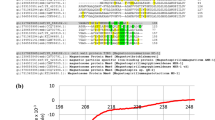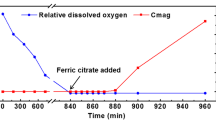Abstract
Magnetotactic bacteria are a diverse group of prokaryotes that share the unique ability of biomineralizing magnetosomes, which are intracellular, membrane-bounded crystals of either magnetite (Fe3O4) or greigite (Fe3S4). Magnetosome biomineralization is mediated by a number of specific proteins, many of which are localized in the magnetosome membrane, and thus is under strict genetic control. Several studies have partially elucidated the effects of a number of these magnetosome-associated proteins in the control of the size of magnetosome magnetite crystals. However, the effect of MamC, one of the most abundant proteins in the magnetosome membrane, remains unclear. In this present study, magnetite nanoparticles were synthesized inorganically in free-drift experiments at 25 °C in the presence of different concentrations of the iron-binding recombinant proteins MamC and MamCnts (MamC without its first transmembrane segment) from the marine, magnetotactic bacterium Magnetococcus marinus strain MC-1 and three commercial proteins [α-lactalbumin (α-Lac), myoglobin (Myo), and lysozyme (Lyz)]. While no effect was observed on the size of magnetite crystals formed in the presence of the commercial proteins, biomimetic synthesis in the presence of MamC and MamCnts at concentrations of 10–60 μg/mL resulted in the production of larger and more well-developed magnetite crystals (~30–40 nm) compared to those of the control (~20–30 nm; magnetite crystals grown protein-free). Our results demonstrate that MamC plays an important role in the control of the size of magnetite crystals and could be utilized in biomimetic synthesis of magnetite nanocrystals.





Similar content being viewed by others
References
Addadi L, Weiner S (1992) Control and design principles in biological mineralization. Angew Chem Int Ed 31:153–169
Amemiya Y, Arakaki A, Staniland SS, Tanaka T, Matsunaga T (2007) Controlled formation of magnetite crystal by partial oxidation of ferrous hydroxide in the presence of recombinant magnetotactic bacterial protein Mms6. Biomaterials 28:5381–5389
Arai T, Norde W (1990) The behavior of some model proteins at solid–liquid interfaces 2. Sequential and competitive adsorption. Colloids Surf 51:17–28
Arakaki A, Webb J, Matsunaga T (2003) A novel protein tightly bound to bacterial magnetic particles in Magnetospirillum magneticum strain AMB-1. J Biol Chem 278:8745–8750
Arakaki A, Masuda F, Amemiya Y, Tanaka T, Matsunaga T (2010) Control of the morphology and size of magnetite particles with peptides mimicking the Mms6 protein from magnetotactic bacteria. J Colloid Interf Sci 343(1):65–70
Bazylinski DA, Garratt-Reed AJ, Frankel RB (1994) Electron microscopic studies of magnetosomes in magnetotactic bacteria. Microsc Res Tech 27:389–401
Bazylinski DA, Frankel RB (2004) Magnetosome formation in prokaryotes. Nat Rev Microbiol 2:217–230
Bruno J, Wersin P, Stumm W (1992) On the influence of carbonate in mineral dissolution: II. The solubility of FeCO3 (s) at 25 °C and 1 atm total pressure. Geochim Cosmochim Acta 56:1149–1155
Chen, Drysdale (1993) Detection of iron binding proteins by a blotting technique. Anal Biochem 212:47–49
Flade K, Lau C, Mertig M, Pompe W (2001) Osteocalcin-controlled dissolution–reprecipitation of calcium phosphate under biomimetic conditions. Chem Mater 13:3596–3602
Garrels RM, Christ CL (1990) Solutions, minerals and equilibria. In: Jones and Bartlett, 2nd edn. Boston, MA, pp 450
Gasteiger E, Hoogland C, Gattiker A, Duvaud S, Wilkins MR, Appel RD, Bairoch A (2005) Protein identification and analysis tools on the ExPASy Server. In: Walker JM (ed) The proteomics protocols handbook. Humana, Totowa, New Jersey, pp 571–607
Grünberg K, Wawer C, Tebo BM, Schüler D (2001) A large gene cluster encoding several magnetosome proteins is conserved in different species of magnetotactic bacteria. Appl Environ Microbiol 67:4573–4582
Grünberg K, Müller EC, Otto A, Reszka R, Linder D, Kube M, Reinhardt R, Schüler D (2004) Biochemical and proteomic analysis of the magnetosome membrane in Magnetospirillum gryphiswaldense. Appl Environ Microbiol 70:1040–1050
Haynes AC, Norde WJ (1994) Interfacial behaviour of biomacromolecules. J Colloid Interf Sci 164:394–409
Hattan SJ, Laue TM, Chasteen ND (2001) Purification and characterization of a novel calcium-binding protein from the extrapallial fluid of the mollusc Mytilus edulis. J Biol Chem 276:4461–4468
Kashyap S, Woehl TJ, Valverde-Tercedor C, Sanchez-Quesada MS, Jimenez-Lopez C, Prozorov T (2014) Iron-binding micelles in acidic recombinant biomineralization protein, MamC. J Nano Mat 320124
Kolinko I, Lohße A, Borg S, Raschdorf O, Jogler C, Tu Q, Posfai M, Tompa E, Plitzko JM, Brachmann A, Wanner G, Müller R, Zhang Y, Schüler D (2014) Biosynthesis of magnetic nanostructures in a foreign organism by transfer of bacterial magnetosome gene clusters. Nat Nanotechnol 9:193–197
Laemmli UK (1970) Cleavage of structural proteins during the assembly of the head of bacteriophage T4. Nature 227:680–685
Lippard SJ, Berg JM (1994) Principles of bioinorganic chemistry. University Science Books, Mill Valley, CA, pp 43–46
Mann S, Frankel RB, Blakemore RP (1984) Structure, morphology and crystal growth of bacterial magnetite. Nature 310:405–407
Mann S, Frankel RB (1989) Magnetite biomineralization in unicellular organisms. In: Mann S, Webb J, Williams RJP (eds) Biomineralization: chemical and biochemical perspectives. VCH, New York, pp 157–182
Martín-Platero AM, Valdivia E, Maqueda M, Martínez-Bueno M (2007) Fast, convenient, and economical method for isolating genomic DNA from lactic acid bacteria using a modification of the protein “salting-out” procedure. Anal Biochem 366:102–104
Martín Ramos JD (2004) XPowder, a software package for powder X-ray diffraction analysis. Legal Deposit GR 1001/04
Matsunaga T, Okamura Y, Fukuda Y, Wahyudi AT, Murase Y, Takeyama H (2005) Complete genome sequence of the facultative anaerobic magnetotactic bacterium Magnetospirillum sp. strain AMB-1. DNA Res 12:157–166
Nudelman H, Zarivach R (2014) Structure prediction of magnetosome-associated proteins. Front Microbiol 5:9
Perez-Gonzalez T, Rodriguez-Navarro A, Jimenez-Lopez C (2011) Inorganic magnetite precipitation at 25 °C: a low-cost inorganic coprecipitation method. J Supercond Nov Magn 24(1–2):549–557
Prozorov T, Mallapragada SK, Narasimhan B, Wang L, Palo P, Nilsen-Hamilton M, Williams TJ, Bazylinski DA, Prozorov R, Canfield PC (2007) Protein-mediated synthesis of uniform superparamagnetic magnetite nanocrystals. Adv Funct Mater 17:951–957
Prozorov T, Bazylinski DA, Mallapragada SK, Prozorov R (2013) Novel magnetic nanomaterials inspired by magnetotactic bacteria: topical review. Mater Sci Eng R 74:133–172
Raj PA, Johnsson M, Levine MJ, Nancollas GH (1992) Salivary statherin. Dependence on sequence, charge, hydrogen bonding potency, and helical conformation for adsorption to hydroxyapatite and inhibition of mineralization. J Biol Chem 267:5968–5976
Reddy LH, Arias JL, Nicolas J, Couvreur P (2012) Magnetic nanoparticles: design and characterization, toxicity and biocompatibility, pharmaceutical and biomedical applications. Chem Rev 112(11):5818–5878
Scheffel A, Gärdes A, Grünberg K, Wanner G, Schüler D (2008) The major magnetosome proteins MamGFDC are not essential for magnetite biomineralization in Magnetospirillum gryphiswaldense but regulate the size of magnetosome crystals. J Bacteriol 190:377–386
Schübbe S, Williams TJ, Xie G, Kiss HE, Brettin TS, Martinez D, Ross CA, Schüler D, Cox BL, Nealson KH, Bazylinski DA (2009) Complete genome sequence of the chemolithoautotrophic marine magnetotactic coccus strain MC-1. Appl Environ Microbiol 75:4835–4852
Sweeton FH, Baes JCF (1970) The solubility of magnetite and hydrolysis of ferrous ion in aqueous solutions at elevated temperatures. J Chem Thermodyn 2(4):479–500
Tanaka M, Okamura Y, Arakaki A, Tanaka T, Takeyama H, Matsunaga T (2006) Origin of magnetosome membrane: proteomic analysis of magnetosome membrane and comparison with cytoplasmic membrane. Proteomics 6:5234–5247
Thomas LA, Dekker L, Kallumadil M, Southern P, Wilson M, Nair SP, Pankhurst QA, Parkin IP (2009) Carboxylic acid-stabilised iron oxide nanoparticles for use in magnetic hyperthermia. J Mater Chem 19:6529–6535
Thomas-Keprta KL, Bazylinski DA, Kirschvink JL, Clemett SJ, McKay DS, Wentworth SJ, Vali H, Gibson JEK, Romanek CS (2000) Elongated prismatic magnetite crystals in ALH84001 carbonate globules: potential Martian magnetofossils. Geochim Cosmochim Acta 64:4049–4081
Valverde-Tercedor C, Abadía-Molina F, Martinez-Bueno M, Pineda-Molina E, Chen L, Oestreicher Z, Lower BH, Lower S, Bazylinski DA, Jimenez-Lopez C (2014) Subcellular localization of the magnetosome protein MamC in the marine magnetotactic bacterium Magnetococcus marinus strain MC-1 using immunoelectron microscopy. Arch Microbiol 196:481–488
Wang L, Prozorov T, Palo PE, Liu X, Vaknin D, Prozorov R (2012) Self-assembly and biphasic iron-binding characteristics of Mms6, a bacterial protein that promotes the formation of superparamagnetic magnetite nanoparticles of uniform size and shape. Biomacromol 13:98–105
Wolff A, Frese K, Wissbrock M, Eckstaedt K, Ennen I, Hetaba W, Loeffler S, Regtmeier A, Thomas P, Sewald N, Schattschneider P, Huetten A (2012) Influence of the synthetic polypeptide c25-mms6 on cobalt ferrite nanoparticle formation. J Nanopart Res 14:1161/1
Wolff A, Mill N, Eckstadt K, Ennen I, Hutten A, Hetaba W, Wissbrock M, Sewald N, Loffler S, Dreyer A, Schattschneider P (2014) Oriented attachment explains cobalt ferrite nanoparticle growth in bioinspired syntheses. Beilstein J Nanotechnol 5:210
Acknowledgments
Financial funding for this work was provided by grants CGL2010-18274 and CGL2013-46612 from the Spanish Ministry of Culture (MEC). We thank Dr. Angel Delgado Mora (Universidad de Granada) for the Z-size analyses and Rafael López Moreno for the assistance in the experiments. We thank the Centro de Instrumentación Científica personnel from the University of Granada for the TEM analyses and technical assistance and to the personnel from La Factoría (Granada) and LAC (IACT, CSIC-UGR) for their help in protein expression and purification. T. Prozorov acknowledges support from the Department of Energy Office of Science Early Career Research Award. Magnetization measurements and part of the electron microscopy analysis were carried out at the Ames Laboratory (US DOE, Iowa State University), contract no. DE-AC02-07CH11358. D.A.B... is supported by US NSF Grant EAR-1423939 and by SC-12-384 (US DOE C02-07CH11358, Ames Laboratory at Iowa State University). Finally, we also thank C.S. Romanek and three anonymous reviewers for their comments and suggestions that have greatly improved this manuscript.
Author information
Authors and Affiliations
Corresponding authors
Electronic supplementary material
Below is the link to the electronic supplementary material.
ESM 1
(PDF 733 kb)
Rights and permissions
About this article
Cite this article
Valverde-Tercedor, C., Montalbán-López, M., Perez-Gonzalez, T. et al. Size control of in vitro synthesized magnetite crystals by the MamC protein of Magnetococcus marinus strain MC-1. Appl Microbiol Biotechnol 99, 5109–5121 (2015). https://doi.org/10.1007/s00253-014-6326-y
Received:
Revised:
Accepted:
Published:
Issue Date:
DOI: https://doi.org/10.1007/s00253-014-6326-y




